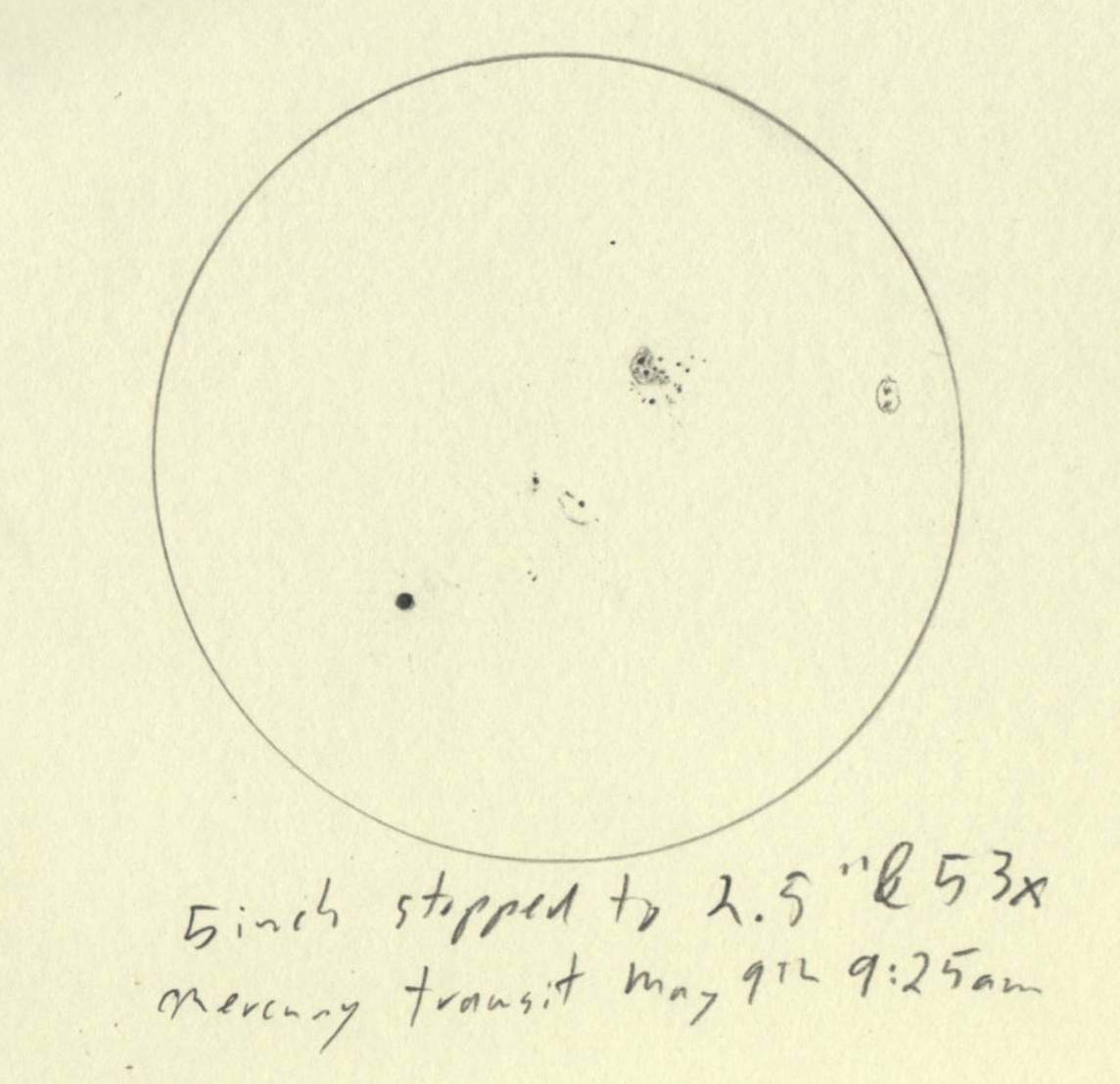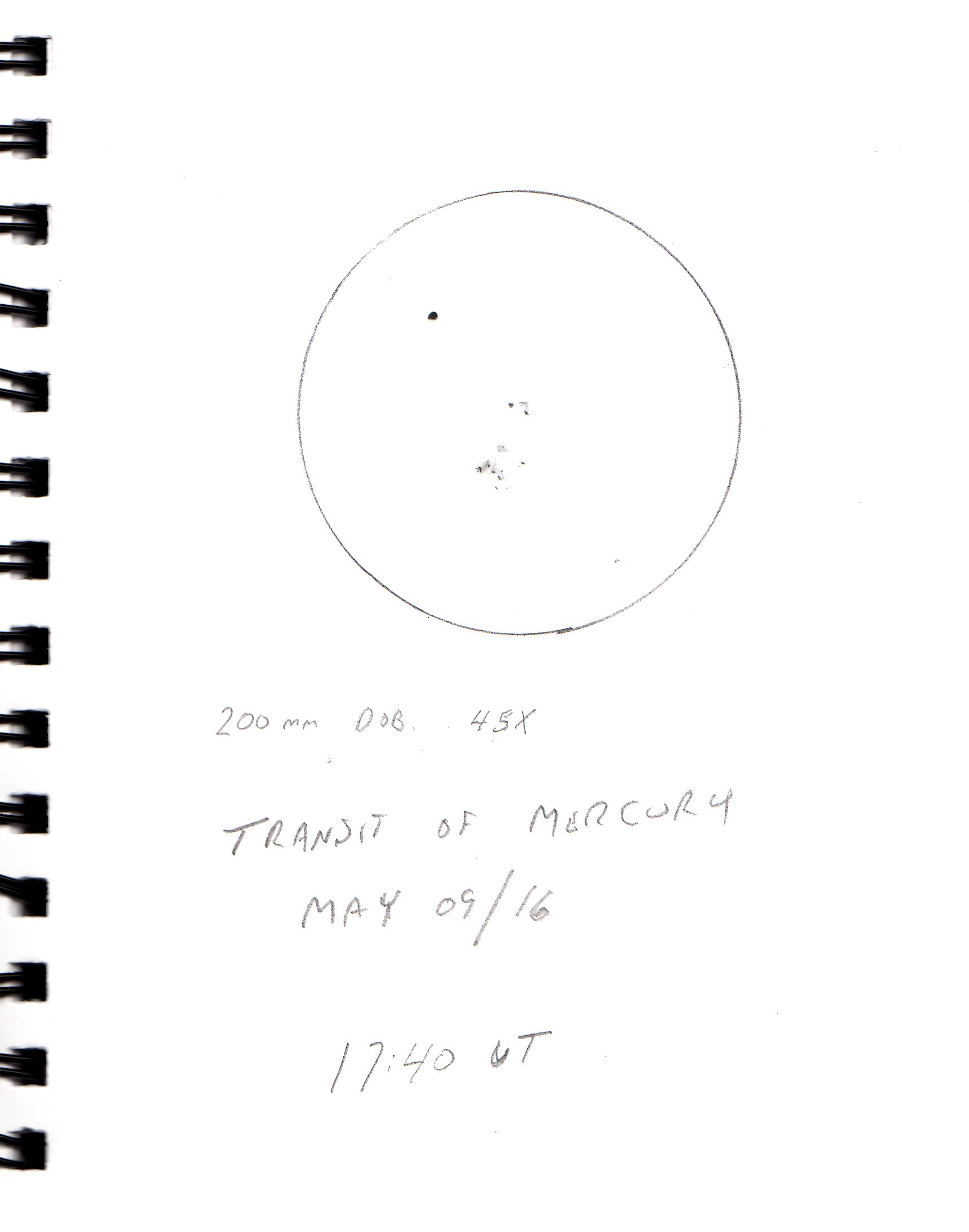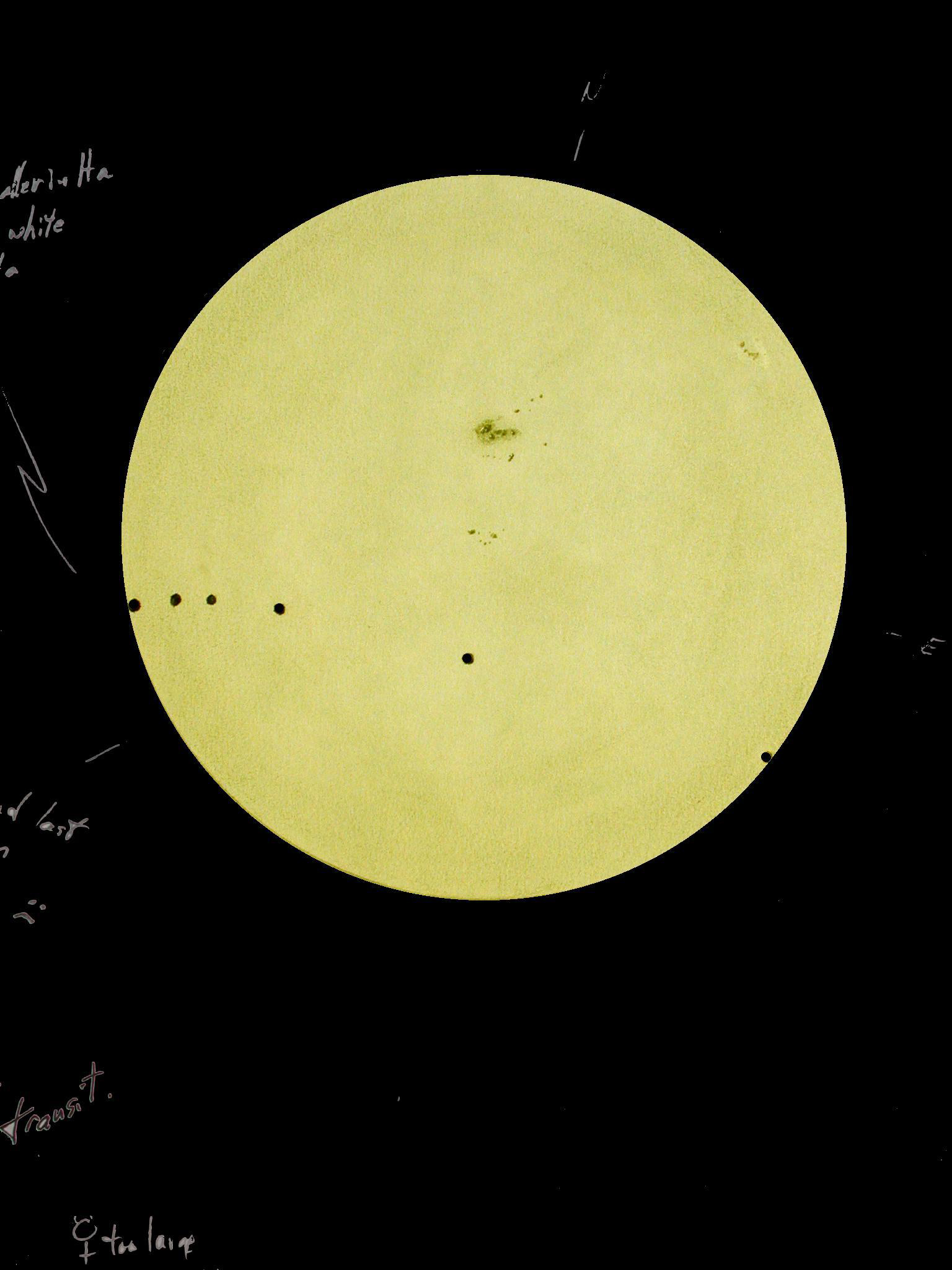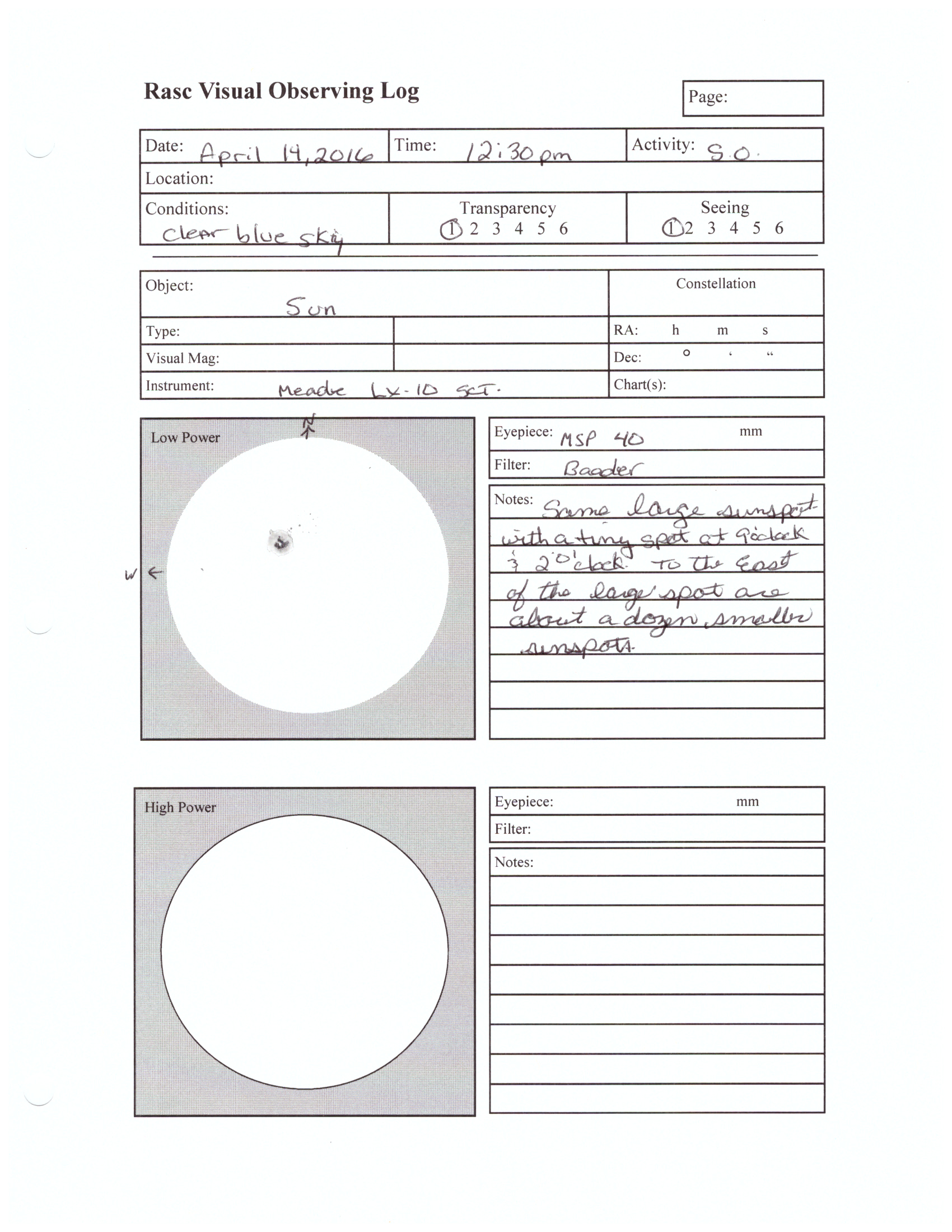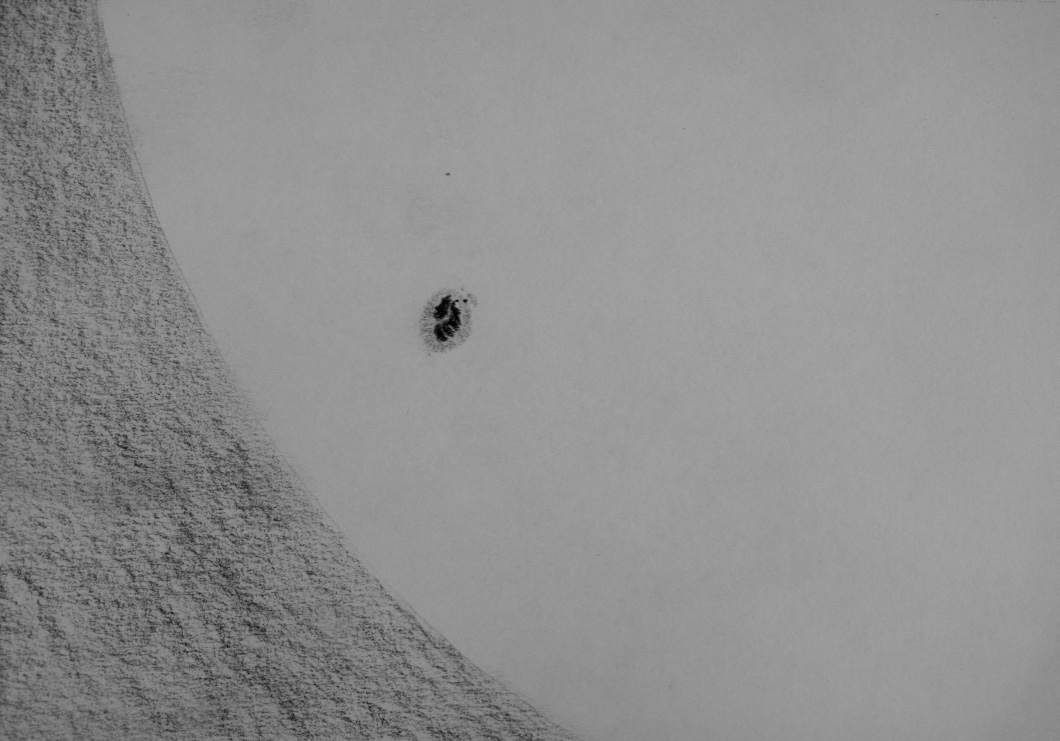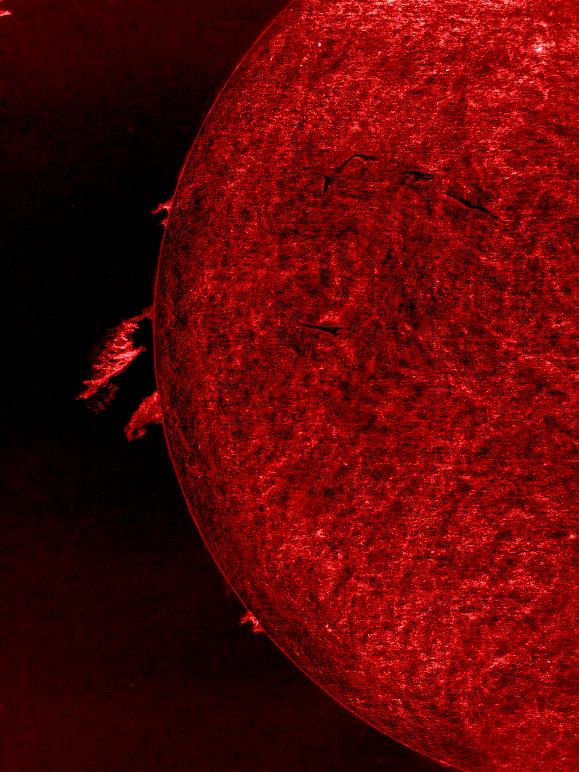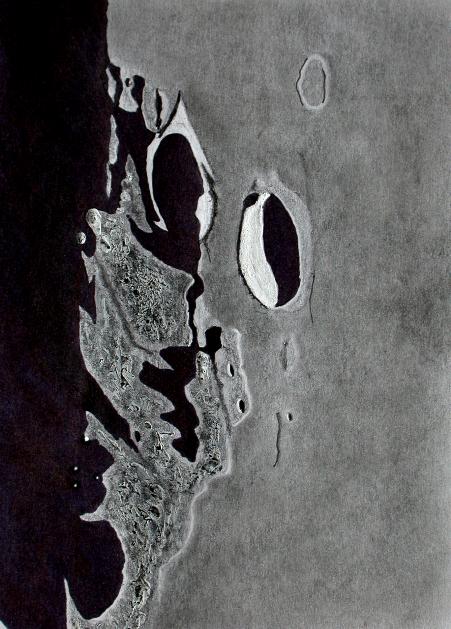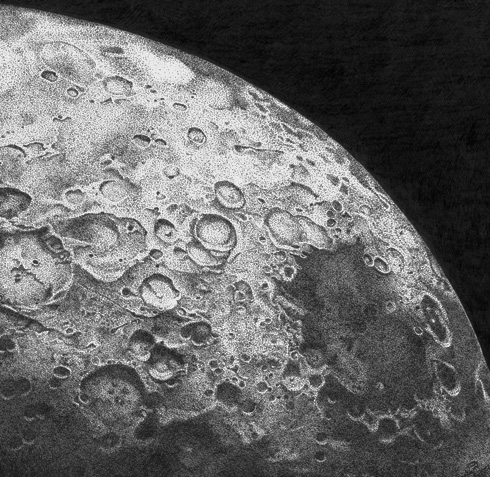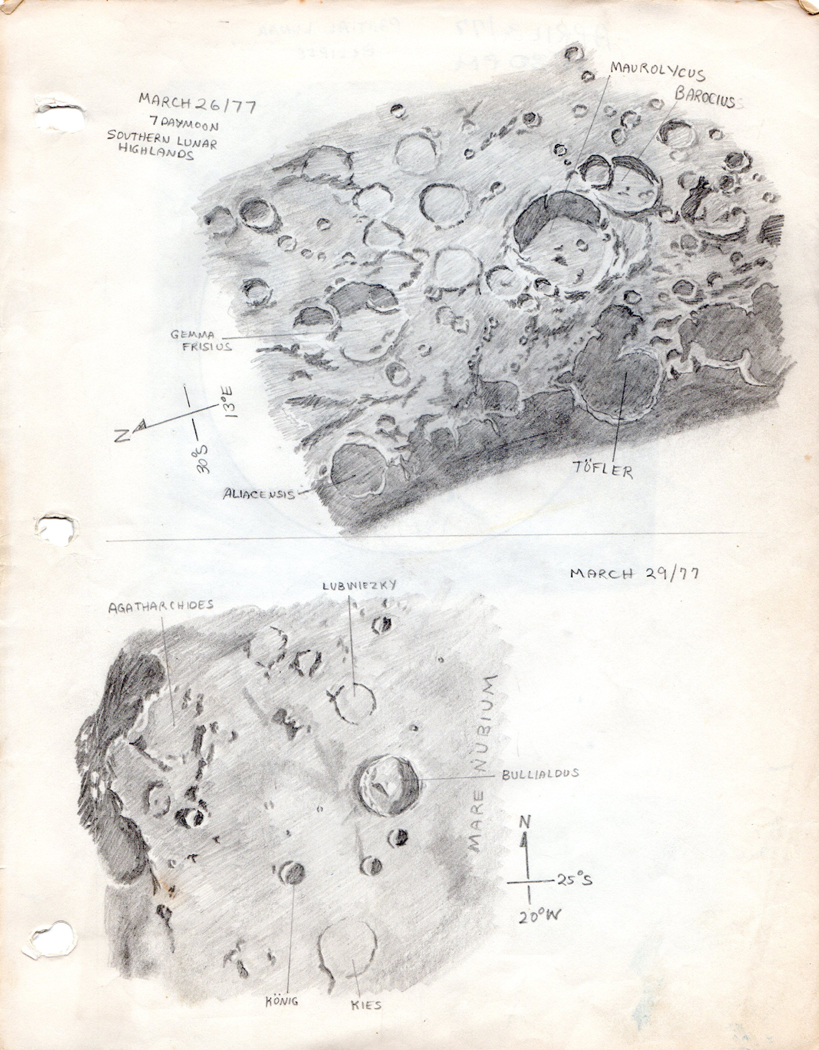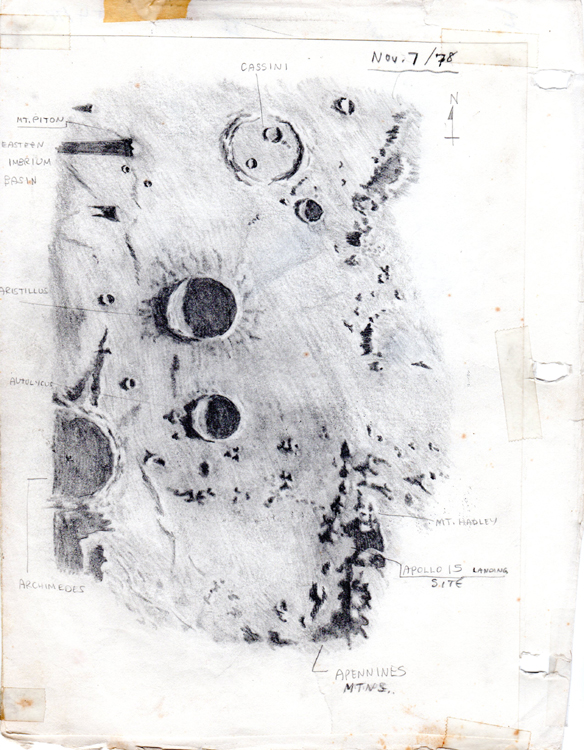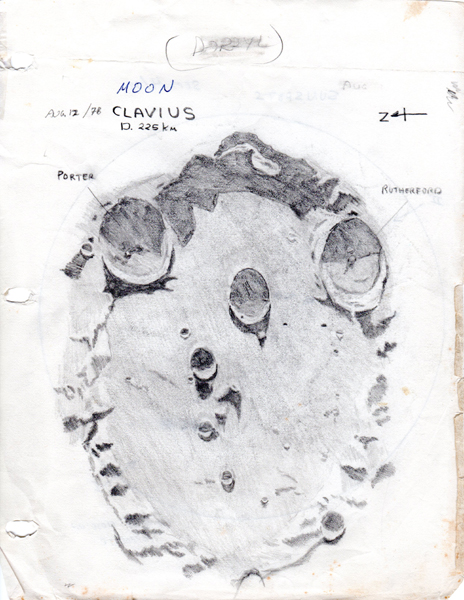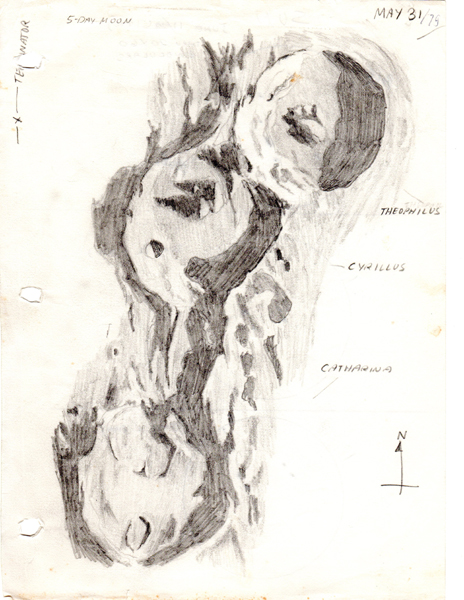| This gallery features the work of members of the RASC Astrosketchers' list. |
Chris Beckett ©
This is my first solar sketch as well as my first sketch of a Stilbonian transit (2016 May 9), however it's my second transit (I observed the TOV with Rosenfeld, O'Brien et al. in 2012), not sure how to render that white spot on the limb...
Clark Muir ©
With more than 7 hours to work with during the transit of Mercury (2016 May 9), I decided to give sketching a try. Thanks Chris for submitting one.
Among my many mistakes, I think the sketch is too small. It is roughly 65mm diameter. As a result subtle detail in the sunspot group is too small.
I used my homemade 8" dobsonian at fairly low power (~47X).
Gerry Smerchanski ©
The nice thing about such transits [of Mercury (2016 May 9)] is the amount of time one has available for the sketch.
This sketch was started half way through, and the earliest Mercury position was put in from noted memory. So with so much time available, it is perplexing to say why so many basic mistakes were made. :-( First off, the scale of the objects on the solar disc are too large. They should have been plotted on a larger Sun. At first it seemed easy to do a simple compilation image by sketching the whole scene and then plotting Mercury as the event transpired--no stacking involved. ;-)
But I had a very tough time plotting the exact position of Mercury. I used certain reference points (spots) and proportions to plot Mercury's position, but I found that using different reference points I got conflicting indications.
I realized that I wasn't looking at a straight line of travel, but I think my curve is exaggerated from what actually took place.
I was viewing the event through both white light and H-alpha, and was tempted to include the H-alpha stuff which was very interesting. Fantastic and unusual filaments were found in several places. But in the end I thought that even though it might make for a more interesting picture, I wasn't sure I could transcribe the different view from the H-alpha scope which had a different orientation without a lot of work.
So the graphite and ink sketch was digitized and flipped to the correct view with north mostly up. A black background was added, and some warm yellow as well to approximate the early view we had through the smoke from distant wildfires.
Viewed through a JSO 5inch SCT and binoviewers at around 90x.
Gerry Smerchanski ©
This is a close-up sketch sunspot AR2529 made between 4 and 5 today (2016 April 14).
It's a very large spot that has a lot of filaments and other features associated with it. The sketch shows a tiny bright spot near the top.
There was second tiny spit near the bottom of the spot, but it was barely detectable in the shimmering afternoon air. The penumbra around this spot was not visible when the big Coronado was tuned to show max detail. So the sketch includes details at various tunings in H-alpha.
Tiny spots in the upper left seem to form while the sketch was made. The wide and diffuse filaments in the bottom right were also changing during the observing time.
Sketch done in graphite pencil, then digitized and coloured to mimic H-alpha seen in a double-stacked Coronado 90 mm.
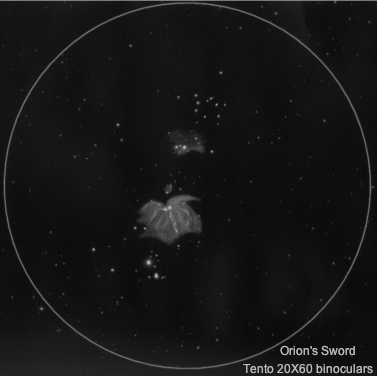
Chris Beckett ©
Last evening (2016 April 3) I saw a great clear sky become overcast, but I'd promised to go out observing, and then couldn't reach my observing partner...so I threw in an old pair of Russian Tento 20X60's (circa 1991) I'd picked up at auction last year for about $99, and drove out to one of our observing sites.
A large sucker hole opened up for about an hour and we looked at Jupiter through the 12-inch and compared my "new" binoculars to his 15X50 Canon IS. The old ruskies really performed well, they resolved all the stars seen in the Canon but the nebulae were much larger and brighter in the old glass; however, stars were not as crisp but about the same as seen in a Nikon AE (a common mid-range binocular), and the eye relief...well I guess they don't have a Russian word for eye relief :)
Anyway, I figured I'd send something out after the chatter on this "best pencil ever", so here's a sketch of Orion's sword I made with the Palimino Blackwing Pearl, plus a little charcoal added in for the M42 nebula.
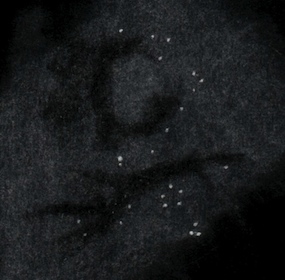
Chris Beckett ©
Here's my 1st attempt (2016 May 3) at a dark nebula sketch, I observe it most summer nights with my 5-inch.
Charcoal erased with a kneaded eraser, and stars plotted using online images and Extra Black 555.
The "E" (B 142+143) looks best in binoculars, while scopes separate the two halves, a "C" to the north (B 143), and "Sandbar" to the south (B 142).
The pencil is a charcoal #2, smudged, erased, & then made negative and adjusted using software. I tried it again using white chalk on black paper, but the chalk erases too easily, and the subtleties are lost. The support is Strathmore 400 Sketch paper (it seems to have a mild cream colour, but that might be the paper grain).
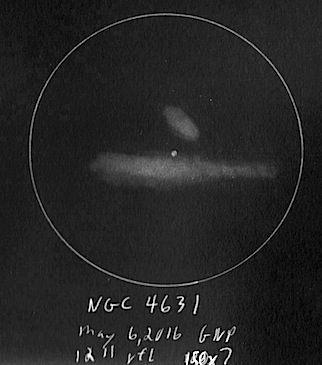
Chris Beckett ©
We observed NGC 4631, the Whale Galaxy in Canes Venatici, last week (2016 May 6) under 6.5 magnitude smokey skies using a 12". I'm unsure of the power. According to Mark Bratton's Herschel Objects, the great astronomer discovered this galaxy on 1787 March 20. While we could not see all the detail in Mark's sketch, p. 113, it was handy having the reference and all the details at our eyepiece.
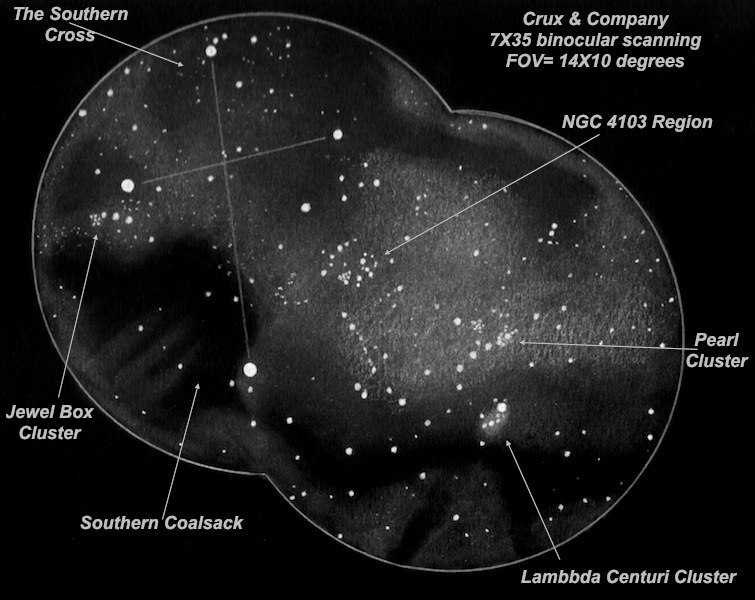
Chris Beckett ©
A couple of binocular fields based on my sketches and observations from the 10,000 foot summit of Haleakala Volcano, Maui (2016 May 16). Hand-drawn and smudged using HB, 4B and 9B wooden pencils, inverted using GIMP then labeled.
Initially I thought the Southern Coalsack was just more VOG (volcanic smog) from the Big Island looming on the southern horizon as this large dark nebula appeared more like an old glass power line insulator than a bag of coal. Apart from seeing the Southern Cross, and Coalsack, the region was not in my observing plan, but the bright star-clouds mixing with dark lanes and star chains were captivating so I decided to make a wide multi-field sketch through binoculars.
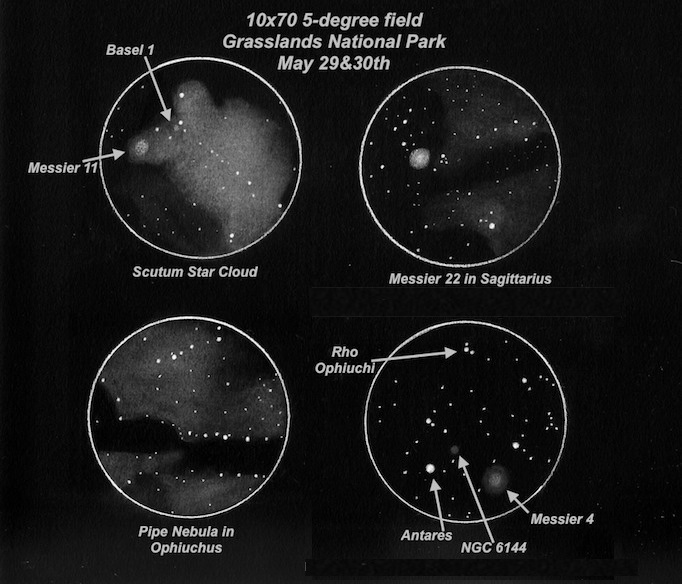
Chris Beckett ©
Late-spring star fields & DSOs (2016 May 29-30).
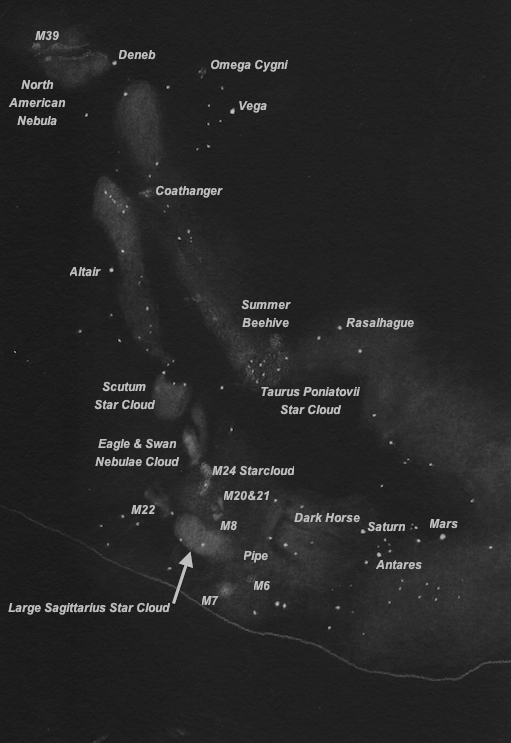
Chris Beckett ©
Unaided-eye graphite pencil drawing (2016 May 31) of the Milky Way rising over the Killdeer Badlands, Grasslands National Park, Southern Saskatchewan.
This represents about 45 minutes sketching over two nights. The first night I sketched Deneb to Altair, next night I decided to do sections complimented with binocular observing and sketches. Once home I choose an orientation, merged them onto a fresh page and smudged. All told about 2 hours, or so.
Tools: Kneaded eraser, Faber Castel smudging tool, graphite pencils - laid out using a Palamino Pearl, Derwent Sketching 4B for smudging and drawing concentrations, "inked" with Generals 9B on Strathmore 400 5.5X8.5 sketch pad. Scanned, inverted and labelled using GIMP.
Gerry Smerchanski ©
The skies this morning (2016 April 1) were quite clear and steady despite what is here now. I have access to the Winnipeg center's PST, and it showed a very large prominence that was disconnected from the solar disc. Most impressive.
So I hauled out a Coronado 90mm double stack H-alpha scope that is on loan with the provision that I document the experience. So what follows is the first instalment to fulfill my obligation.
The very large prominence was slowly changing as I observed it over the first half hour. What looked disconnected in the small scope showed tenuous connections to the disc. The image scale of the larger scope is such a treat. The Coronado 90 DS is quite demanding in regard to how you set it up, and takes quite a bit of adjusting to get the kind of view you want. There were other prominences, especially a very cool one on the other side of the Sun, where the dark could be traced to the limb where it appeared as a normal prominence. This demonstrates that filaments and prominences are the same, but the former are viewed from above and against the bright disc of the Sun so that they look dark. But I couldn't decide how to sketch where the same feature went from dark to light. So I went back to the large prominence which allowed me to make a usual astro sketch in negative fashion (dark is light à la drawing a nebula).
So this is a regular pencil sketch on white paper that was just inverted and contrast added to get around the problem of digitizing the sketch. And then colour was added to mimic the view I saw in H-alpha. Note the filaments in the upper right-hand part of the image. They were a bit more prominent than the sketch portrays.
This is my first solar sketch so it's gonna take some experimenting to get the technique to reflect the visual experience. The mottling on the disc is representative of the surface, but not entirely accurate (too pronounced). The filaments (dark lines on the disc) are more accurate, but they should stand out more.
Coronado 90mm double stack with binoviewer at around 35x.
Great for observing last night (2016 April 18) in Manitoba's Interlake region. Jupiter looking good, but not much happening there, with all the moons off to one side, and no GRS in the early evening.
The Moon did show some interesting formations under some compelling lighting angles, but I was again 'drawn' to the Aristarchus plateau. Libration had 'squeezed' things a bit from what I have seen in the past. This made things look a bit odd to me. Lots happening there.
Too much happening, as I found out when I tried to sketch it all. I have sketched this region before, but wanted to try the highland region at a larger scale, as the wonderful Schroter's valley was not out of the shadows over much of its whole length. It was almost lost in the shadows nearer the terminator and not clear, and trying to get the highlands right led to mixed results. I hate doing rough terrain, and especially ejecta blankets. To make the task manageable I do the highlights first with the whiteout. This leaves a rough texture for the graphite applied on top. If you control the direction of your pencil so that you are always going towards the light, you end up with rather realistic shadows on the 'correct' side of each brighter spot. It does give a reasonably accurate impression, even if not entirely accurate.
Herodotus crater was left rather unfinished due to time constraints - I should fix it up. And the sketch cannot capture the dynamic range of brightness experienced, so it's rather nice that digital enhancements can be done to get the range closer to the visual experience. Of note is the extremely bright inner wall of Aristarchus, and the unusually bright tiny peak right on the terminator at lower left. It was so bright that even the enhanced version doesn't quite capture it. It was a real beacon. There's nothing like seeing it for yourself.
April 18th 9 to 10:30 CDT 100mm Skywatcher ED f/10 refractor, binoviewers with 2x Barlow.
Shawn Martin ©
I thought I’d start by sharing an image I drew a few years back. Its part of the cover image of a fantastic book, Michael Light’s Full Moon. It contains detailed images of the Moon from the Apollo Missions. I decided to use this image because it was a challenge as an artist. And being an amateur astronomer I am always in awe of the beauty of astronomical objects and now have turned my hand to replicating them as best I can. The process of this particular drawing is a pen and ink stipple tone. The thousands of dots allow for very fine details and smooth transitional tone gradients. I think it came out alright.
Peter Daniel ©
These excellent lunar sketches were done in the 1970s by Peter Daniel. They were brought to our attention by Clark Muir of the Kitchener-Waterloo Centre. Much can be learned from their study.
Peter Daniel ©
These excellent lunar sketches were done in the 1970s by Peter Daniel. They were brought to our attention by Clark Muir of the Kitchener-Waterloo Centre. Much can be learned from their study.
Peter Daniel ©
These excellent lunar sketches were done in the 1970s by Peter Daniel. They were brought to our attention by Clark Muir of the Kitchener-Waterloo Centre. Much can be learned from their study.
Peter Daniel ©
These excellent lunar sketches were done in the 1970s by Peter Daniel. They were brought to our attention by Clark Muir of the Kitchener-Waterloo Centre. Much can be learned from their study.
|
This gallery is curated by R.A. Rosenfeld for the Astroketchers' list. |

